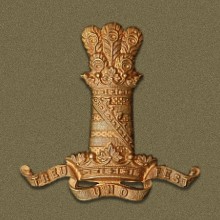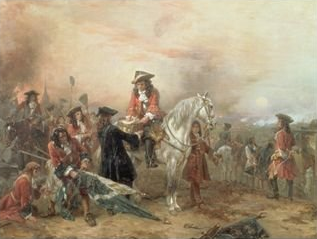
The 11th Hussars (Prince Albert's Own) was a cavalry regiment of the British Army established in 1715. It saw service for three centuries including the First World War and Second World War but then amalgamated with the 10th Royal Hussars (Prince of Wales' Own) to form the Royal Hussars in 1969.

The Royal Regiment of Horse Guards, also known as the Blues, or abbreviated as RHG, was one of the Cavalry regiments of the British Army, and part of the Household Cavalry. In 1969, it was amalgamated with the 1st The Royal Dragoons to form the Blues and Royals.

Henry William Engleheart VC was an English recipient of the Victoria Cross, the highest and most prestigious award for gallantry in the face of the enemy that can be awarded to British and Commonwealth forces.

Samuel Parkes VC was an English recipient of the Victoria Cross, the highest and most prestigious award for gallantry in the face of the enemy that can be awarded to British and Commonwealth forces. Parkes was awarded his VC for his actions during the Charge of the Light Brigade.

The King's Royal Hussars (KRH) is a Royal Armoured Corps regiment of the British Army formed in 1992. Based at Tidworth it serves as the armoured regiment of the 12th Armoured Brigade Combat Team (ABCT). Under Army 2020 Refine, it is intended to exchange its Challenger 2 tanks for Ajax vehicles.

The Royal Green Jackets (Rifles) Museum is situated at Peninsula Barracks in Winchester, England. The museum is one of several regimental museums that form part of Winchester's Military Museums.

The Royal Horse Artillery (RHA) was formed in 1793 as a distinct arm of the Royal Regiment of Artillery to provide horse artillery support to the cavalry units of the British Army. Although the cavalry link remained part of its defining character, as early as the Battle of Waterloo the RHA was sometimes deployed more along the lines of conventional field artillery, fighting from comparatively fixed positions.

The Royal Hussars (Prince of Wales's Own) was a cavalry regiment of the British Army. It was formed by the amalgamation of the 10th Royal Hussars and the 11th Hussars in 1969 and it amalgamated with the 14th/20th King's Hussars to form the King's Royal Hussars in 1992.

The 10th Royal Hussars (Prince of Wales's Own) was a cavalry regiment of the British Army raised in 1715. It saw service for three centuries including the First World War and Second World War but then amalgamated with the 11th Hussars (Prince Albert's Own) to form the Royal Hussars (Prince of Wales's Own) in October 1969.

Robert Alexander Hillingford was an English painter. He specialized in historical pictures, often battle scenes.

The 18th Royal Hussars (Queen Mary's Own) was a cavalry regiment of the British Army, first formed in 1759. It saw service for two centuries, including the First World War before being amalgamated with the 13th Hussars to form the 13th/18th Royal Hussars in 1922.

The 12th Royal Lancers was a cavalry regiment of the British Army first formed in 1715. It saw service for three centuries, including the First World War and the Second World War. The regiment survived the immediate post-war reduction in forces, but was slated for reduction in the 1957 Defence White Paper, and was amalgamated with the 9th Queen's Royal Lancers to form the 9th/12th Royal Lancers in 1960.

The 8th King's Royal Irish Hussars was a cavalry regiment in the British Army, first raised in 1693. It saw service for three centuries including the First and Second World Wars. The regiment survived the immediate post-war reduction in forces, and went on to distinguish itself in the battles of the Korean War, but was recommended for amalgamation in the 1957 Defence White Paper prepared by Duncan Sandys. The regiment was amalgamated with the 4th Queen's Own Hussars, to form the Queen's Royal Irish Hussars in 1958.

The 7th Queen's Own Hussars was a cavalry regiment in the British Army, first formed in 1689. It saw service for three centuries, including the First World War and the Second World War. The regiment survived the immediate post-war reduction in forces, but following the 1957 Defence White Paper, it was amalgamated with the 3rd The King's Own Hussars, forming the Queen's Own Hussars in 1958.
Godfrey Douglas Giles was a painter of horses, military scenes and battles, many experienced firsthand while on service with the British Army in India, Afghanistan, Egypt and South Africa. He produced numerous caricatures for the magazine Vanity Fair.
In countries whose armies are organised on a regimental basis, such as the army of the United Kingdom, a regimental museum is a military museum dedicated to the history of a specific army regiment.

The regimental depot of a regiment is its home base for recruiting and training. It is also where soldiers and officers awaiting discharge or postings are based and where injured soldiers return to full fitness after discharge from hospital before returning to full duty. Normally, a variety of regimental stores will also be kept at the depot. The regimental depot is not the same as the regimental headquarters, though in practice the two will often be co-located.

William Barnes Wollen was an English painter mostly known for his paintings of battle and historical scenes and sporting events.

The Peninsula Barracks are a group of military buildings in Winchester, Hampshire.
The 1st Cavalry Brigade was a brigade of the British Army. It served in the Napoleonic Wars, the Anglo-Egyptian War, the Boer War and in the First World War when it was assigned to the 1st Cavalry Division.


















